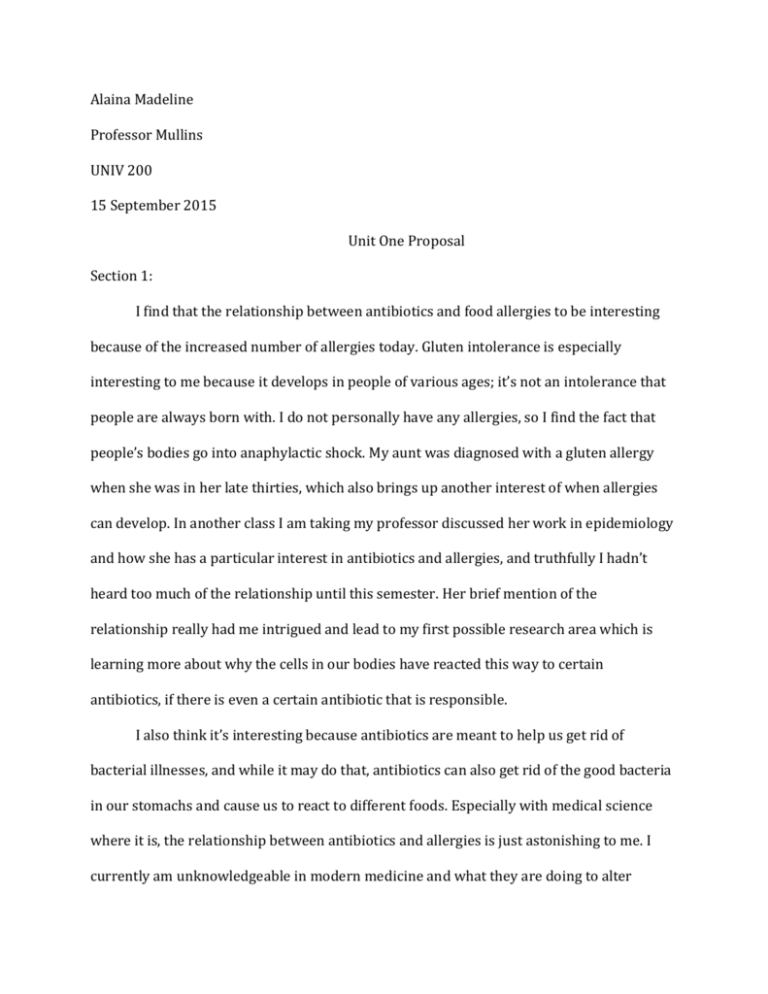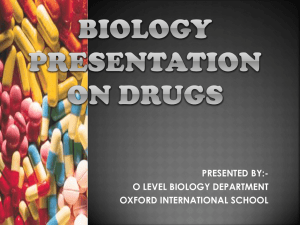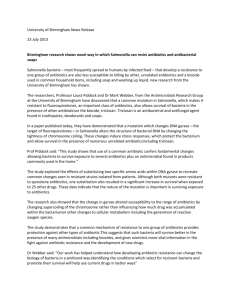paper proposal
advertisement

Alaina Madeline Professor Mullins UNIV 200 15 September 2015 Unit One Proposal Section 1: I find that the relationship between antibiotics and food allergies to be interesting because of the increased number of allergies today. Gluten intolerance is especially interesting to me because it develops in people of various ages; it’s not an intolerance that people are always born with. I do not personally have any allergies, so I find the fact that people’s bodies go into anaphylactic shock. My aunt was diagnosed with a gluten allergy when she was in her late thirties, which also brings up another interest of when allergies can develop. In another class I am taking my professor discussed her work in epidemiology and how she has a particular interest in antibiotics and allergies, and truthfully I hadn’t heard too much of the relationship until this semester. Her brief mention of the relationship really had me intrigued and lead to my first possible research area which is learning more about why the cells in our bodies have reacted this way to certain antibiotics, if there is even a certain antibiotic that is responsible. I also think it’s interesting because antibiotics are meant to help us get rid of bacterial illnesses, and while it may do that, antibiotics can also get rid of the good bacteria in our stomachs and cause us to react to different foods. Especially with medical science where it is, the relationship between antibiotics and allergies is just astonishing to me. I currently am unknowledgeable in modern medicine and what they are doing to alter antibiotics to reduce the number of allergies correlated with the antibiotics, but another possible research question would be a close examination into what specific allergies are related to antibiotic usage. I already have a bias towards some antibiotics and some exposure to antibiotics being related to allergies. I believe that not all antibiotics are related to allergies and not all allergies are related to antibiotics, but with some antibiotics and exposures I do think there is a correlation. While I am doing my research, I will have to pay attention to myself disregarding sources or articles that say antibiotics may not affect allergies or them not showing a strong relationship. I will also have to make sure when I cite a source in my paper that I don’t take the facts or research out of context so they agree with my argument. I also need to take into account other factors that could be related to allergies. For example, lactose intolerances can develop from a lack of lactose in ones diet. Cultural influences could also play into account. In America allergies, or diets similar to that of someone with an allergy, almost seem to be a fad. Such as the gluten free diet, not everyone has Celiac Disease, but some choose to not have gluten in their diets. This trend has even caused restaurants to change menus by making Gluten free options and grocery stores are providing more options for diets similar. As far as my research experience, last semester I did a research paper on the value of outdoor education on inner city youth. I focused on the city of Richmond and on elementary aged children. I emailed directors and interns of 3 outdoor camp organizations to get their perspective on how their programs have changed the lives and even the courses of lives of these children in Richmond. I also used VCU Libraries online search tool to find articles online, as well as going to the Library to find books and other sources. Section 2: Having an allergy can be an issue, and is something most American’s deal with. According to osteopathic physician, Dr. Mercola, 15 million American’s have an allergy (Mercola). With only about 321 million people living in America (“U.S. and World Population Clock”) that is only about 4.6% of Americans, which doesn’t seem like much. However, to put it in perspective, the unemployment rate, as of May 2015, is 5.1% (“Employment Situation Summary”). The percentages are so similar, and unemployment is such a burning topic for most Americans and is even one of the main topics for those trying to run for President. Unemployment and allergies aren’t quite comparable in the scope of severity, but they both affect almost the same amount of people in America. The CDC also did a report that said that one out of 13 children has an allergy, which equates to about two children per classroom (“Facts and Statistics”). Those two students in the class are affected by the allergy, but then the rest of the class is also affected by the allergy when it comes to what snacks that can and cannot be brought into the classroom. In another study published in 2103 by CDC, the number of children who have an allergy has gone up by nearly 50% from 1997 to 2011 (“Facts and Statistics”). Children and the newer generations are the ones most affected by this increase in allergies and intolerances to food. The rate at which children are growing out of some allergies is slowing down too. In the past, research has shown by the time children are in school, they have out grown their allergies to cow’s milk, soy, and egg, but a recent study at Johns Hopkins show that most children aren’t completely growing out of their allergies until age 16 (“Facts and Statistics”). Not only are children not growing out of their allergies until high school, but this also leads to more people being affected by these allergies. Foodallergy.org claims, that “every 3 minutes, a food allergy reaction sends someone to the emergency department – that is more than 200,000 emergency department visits per year (“Facts and Statistics”). Whether an adult with allergies or a child with allergies, hospital staff and resources are being used even more on allergies with the influx of those affected. This factor of going to the emergency room also contributes to the approximate $25 billion spent on food allergies spent each year (“Facts and Statistics”). Section 3: With the increased number of bacterial infections having antibiotics to get rid of the effects, medical professionals have done more research in how antibiotics are affecting the human body. For example, the bacteria are adapting to the antibiotics, making the antibiotics useless in trying to kill the bacteria causing a disease or infection (Mayo Clinic Staff). This can be dangerous because the antibiotics are still killing some bacteria in the body, and more likely than not, its the good bacteria that is being killed. An example of the good bacteria is called gut flora. Gut flora is there to support proper digestion and immunization. In the case of using strong doses of antibiotics to get rid of an infection, the gut flora may also get wiped away leaving the resistant bacteria behind (Krans). Having resistant bacteria, as the only bacteria in the intestines can be detrimental to ones health. These bacteria can cause nasty infections that has lead to about 23,00 deaths per year, according to the CDC (“Antibiotic Resistance Threats in the US”). Thousands aren’t millions, but the damage overuse of antibiotics and strong antibiotics can cause can be frightening. While the medical professionals have done the research and know facts about antibiotics and bacteria, nonprofessionals have their own myths and opinions about the subject. One myth that some believe is that antibiotics work well for colds. Colds are caused by viruses, which cannot be treated with antibiotics (“Myth: Antibiotics Are Great for Colds”). Antibiotics are used to treat bacterial infections, fungi infections, and sometimes parasites. Another common myth is that antibiotics used in animals are the biggest cause of the drug resistant bacterial diseases in humans. In present day medicine, some of the bacterial diseases that doctors are having the most concern for include MRSA, drug resistant tuberculosis and Neisseria gonorrhea ("Fact or Fiction: Common Antibiotic Myths"). Antibiotics used in animals don’t cause widespread cases of resistant bacterial diseases to the point medical doctors are having an issue with it, that’s not to say it may not be a small factor. A typical misconception is that antibiotics don’t have side effects. Antibiotics, like other medications, come with their own list of side effects including diarrhea and yeast infections. In fact, almost one in five emergency room visits related to drug side effects are from antibiotics (Carr). One final misconstrued myth is that it is okay to use antibiotics “just in case”. Taking antibiotics without seeing a doctor who then prescribes you antibiotics can lead to resistant bacteria and/or the wiping out of the good bacteria, which can lead to worse side effects down the road. Works Cited "Antibiotic Resistance Threats in the US." Centers for Disease Control and Prevention. Centers for Disease Control and Prevention, 16 Sept. 2013. Web. 07 Sept. 2015. Carr, Teresa. "Myths About Antibiotics - Consumer Reports." Myths About Antibiotics Consumer Reports. N.p., 25 June 2015. Web. 07 Sept. 2015. "Employment Situation Summary." U.S. Bureau of Labor Statistics. U.S. Bureau of Labor Statistics, 04 Sept. 2015. Web. 07 Sept. 2015. "Facts and Statistics." Food Allergy Research & Education. N.p., n.d. Web. 07 Sept. 2015. "Fact or Fiction: Common Antibiotic Myths." Animal Health Institute. N.p., n.d. Web. 07 Sept. 2015. Krans, Brian. "5 Frightening Consequences of Overusing Antibiotics." Healthlinews RSS News. N.p., 11 Mar. 2014. Web. 07 Sept. 2015. Mayo Clinic Staff. "Consumer Health." Antibiotics: Misuse Puts You and Others at Risk. N.p., 12 Dec. 2014. Web. 07 Sept. 2015. Mercola, Joseph. "Link Found Between Food Allergies and Farm Antibiotics." Mercola.com. N.p., 17 Sept. 2014. Web. 07 Sept. 2015. "Myth: Antibiotics Are Great for Colds." CBSNews. CBS Interactive, n.d. Web. 07 Sept. 2015. "U.S. and World Population Clock." The United States Census Bureau. N.p., 7 Sept. 2015. Web. 7 Sept. 2015.






